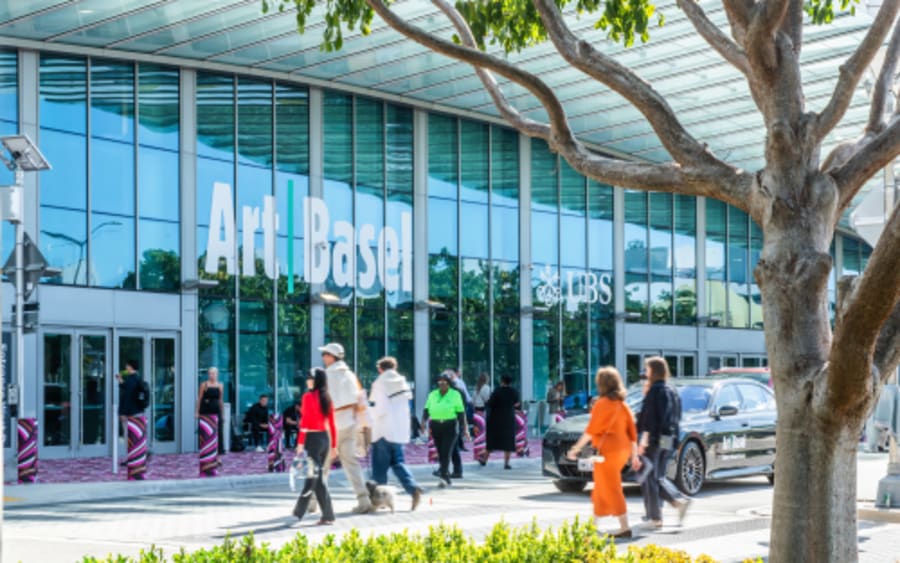A pack of robot dogs with human heads will be unleashed inside the Miami Beach Convention Center next month. Modeled after public figures such as Andy Warhol, Jeff Bezos, and Elon Musk, the four-legged bots will snap photos of fairgoers at Art Basel Miami Beach, some of which will contain a code linked to a free NFT. This tongue-in-cheek work by American artist Beeple (Mike Winkelmann) will be at the heart of Art Basel’s new curated space, Zero 10, dedicated to digital and new media art.
Beeple’s interactive installation, which scrutinizes the increasing autonomy of robots and AI, is one of many works in Zero 10 that examine our complex relationship with the digital world. ‘The space interrogates what emerging technologies mean and represent in society,’ says Eli Scheinman, curator of the space. ‘The artists are contributing to this discourse using cutting-edge tools and media.’
The initiative takes its name from Russian avant-garde artist Kazimir Malevich’s 1915 exhibition ‘The Last Futurist Exhibition of Paintings 0,10’, staged in Petrograd (now Saint Petersburg). The show was credited with introducing a groundbreaking new era in avant-garde art. In a similar vein, the works on view in Miami venture into new terrain. Alongside experimental digital pieces, there will be prints, sculpture, installation, and video works that engage with artificial intelligence, generative systems, and robotics.
Zero 10 – which is a mix of booths and freestanding works, as well as the aforementioned robot dogs– features 12 exhibitors. The list includes a mix of leading digital platforms, such as Art Blocks, AOTM, and SOLOS, alongside galleries with physical locations such as Pace Gallery, Nguyen Wahed, and Fellowship. UBS are also loaning an immersive video installation by Chinese artist Lu Yang.
While creatives in the digital ecosystem are often isolated from the contemporary art world, Scheinman says Zero 10 aims to break down boundaries and spark new dialogue. Located opposite the Meridians sector, it allows visitors to draw connections between analog and digital works.
Many of the artists selected for Zero 10 are pioneers in the field, such as German artist Manfred Mohr, often regarded as the godfather of generative art. Bitforms Gallery will be showing Mohr’s first live generative program, which randomly selects and displays colorful patterns based on paths through a six-dimensional cube – a shape that exists only in mathematics – together with a series of printed canvases.
Nearby will be Quine, a new generative art project by Larva Labs (Matt Hall and John Watkinson). The duo is best known for their famed CryptoPunks series, which became icons of the NFT boom. Quine consists of vibrant geometric images created from code that can reproduce itself. While the series exists digitally and includes an NFT component, the artists will present 10 physical prints at the fair.
Despite the enormous hype surrounding NFTs, many in the art world remain unconvinced of their value. Artist XCOPY and Visualize Value (Jack Butcher) will confront this issue in interactive works that cast a critical eye on how the digital art ecosystem intersects with financial markets.
Art Basel has long engaged with questions like this through various initiatives such as Digital Dialogues, a global conversation series on art and technology. Earlier this year, the Hong Kong fair had a full aisle of digital installations in the Encounters sector. Highlights included works by Canadian artist Jon Rafman and New York-based artist Alison Nguyen exploring issues of hyperconnectivity and how technology mediates memory and history. Last year at the Miami fair, AI artist Huemin and Dream Computing showed DREAM-0, a limited-edition series of 10 interactive AI machines that allowed audience members to generate artwork.
The launch of Zero 10 arrives at a time when tech-driven art continues to gain traction in the art world. An increasing number of institutions are recognizing the medium, acquiring technology-driven works, and dedicating exhibitions to digital art.
According to The Art Basel and UBS Survey of Global Collecting 2025, digital art has become a key acquisition category among high-net-worth collectors. More than half (51%) of the 3,100 respondents had purchased a digital artwork in 2024 or 2025. The medium ranked third in total spending, after painting and sculpture. After years of fluctuations, the average share of digital art in collections surged from just 3% in 2024 to 13% in 2025.
Despite growing interest in the field, many still relegate digital art to the margins of the contemporary art world. ‘But skepticism is healthy,’ says Scheinman. ‘If their work is challenging traditional norms, these artists must be doing something right.’
Payal Uttam is an independent writer and editor who divides her time between Hong Kong and Singapore. She contributes to a range of publications including The Art Newspaper, South China Morning Post, and The Wall Street Journal.
Caption for header image: Ix Shells, Eva Bonnier (#2), Still from Video, 2025. Courtesy of the artist. Copyright by Fellowship 2025.
Published November 12, 2025.


